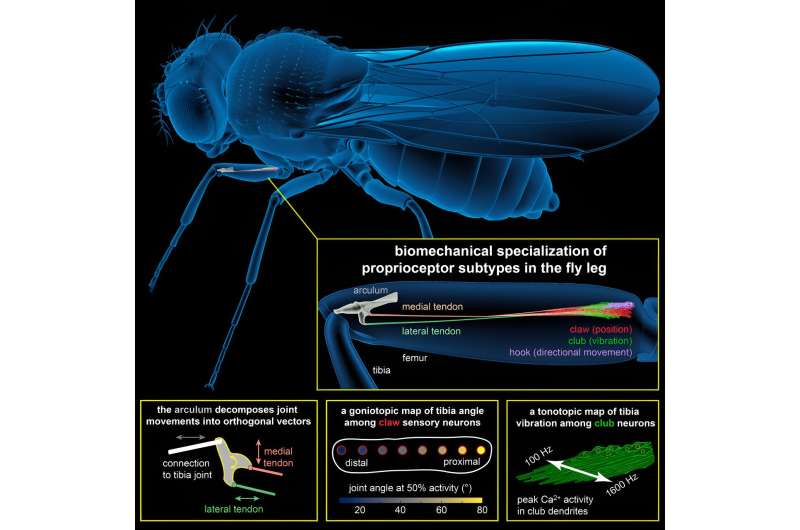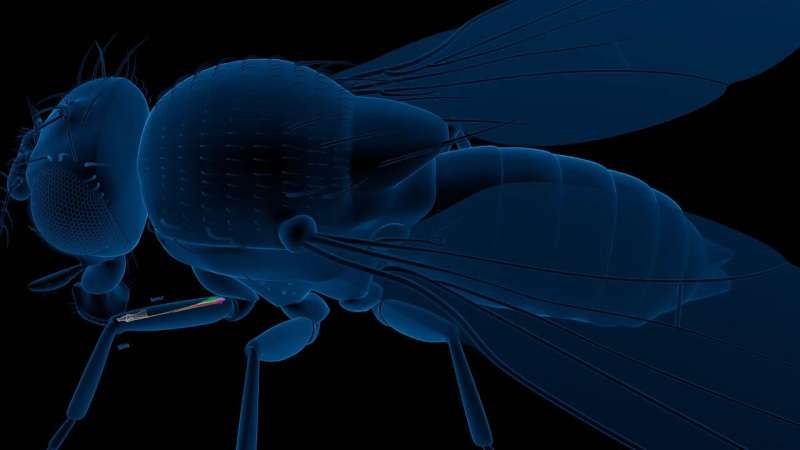August 25, 2023 feature
This article has been reviewed according to Science X's editorial process and policies. Editors have highlighted the following attributes while ensuring the content's credibility:
fact-checked
peer-reviewed publication
trusted source
proofread
Study unveils new mechanical and neural processes underpinning proprioception in fruit flies

Drosophila, commonly known as fruit flies, have been the focus of numerous biomedical and neuroscientific studies, as they can be easily bred, examined and experimented on. Over the years, studies on Drosophila have led to numerous exciting discoveries, paving the way for the development of new pharmaceutical drugs, as well as flying robots and other technologies.
Researchers at University of Washington, Baylor College of Medicine, Harvard Medical School, University of Western Ontario and other institutes recently uncovered new mechanical and biological processes in these tiny insects, which support their ability to sense their own location and movements in space, known as proprioception. The paper, published in Neuron, could have valuable implications both for future biological and robotics research.
"In a previous paper, we discovered that proprioceptive sensory neurons in the fly leg detect different aspects of joint movement, such as position, movement, and vibration," John Tuthill, one of the researchers who carried out the study, told Medical Xpress.
"The logical next step was to determine how these different sensory neurons, which are mechanically coupled to the same joint, detect different stimuli. In this paper, we considered two alternative hypotheses: (1) that each proprioceptor class expresses different mechanosensory ion channels that detect different stimuli or (2) that each proprioceptor class is subjected to different mechanical forces due to biomechanical specialization."
To test their hypotheses, Tuthill and his colleagues analyzed data previously collected as by a group of their collaborators at Harvard Medical School. This data consisted in images of the Drosophila leg taken using an imaging method called X-ray holographic nano-tomography.

"The first breakthrough came when our collaborators in Wei Chung Lee's lab imaged a fly leg in an X-ray synchrotron," Tuthill explained. "From the dataset they compiled, we were able to reconstruct all the proprioceptors and tendons, which revealed that the different classes of sensory neurons are attached to the tibia joint in different ways. This allowed us to build a biomechanical model of how they are mechanically stimulated as the leg moves."
After they had compiled their biomechanical model of the Drosophila leg, the researchers tested its predictions using calcium imaging, a microscopy technique that can be used to track the activity of neurons over time. They specifically used this optical technique to examine the activity of proprioceptor neurons in the leg of fruit flies as their tibia moved.
"First, we discover an elegant mechanical contraption in the fly leg, called the arculum, that effectively splits joint movements into high and low frequencies, which it routes to different proprioceptors," Tuthill said. "Second, we discovered that proprioceptive sensory neurons in the fly leg encode a topographic map of joint angle. Other sensory arrays, like the retina and cochlea, contain topographic maps, but this is the first we have heard of a proprioceptive map."
The sophisticated mechanical component unveiled by Tuthill and his colleagues was found to play a key part in the insect's proprioception. In the future, roboticists could try to artificially replicate this component in robotic system, to enhance their ability to sense their location, body and movements in their surrounding environment.
Concurrently, the discovery of the process through which the legs of flies encode topographic maps of their surrounding environment could inform additional research in biology. Specifically, other teams could try to uncover similar processes in other animals.
"One of our next goals will be to use anatomical reconstructions like this one to build larger, more accurate biomechanical models of the limb, which can be used to simulate mechanical interactions with the environment," Tuthill added. "For example, we could simulate how the leg moves when specific muscles contract during walking, and how these movements are sensed by proprioceptors."
More information: Akira Mamiya et al, Biomechanical origins of proprioceptor feature selectivity and topographic maps in the Drosophila leg, Neuron (2023). DOI: 10.1016/j.neuron.2023.07.009
© 2023 Science X Network



















